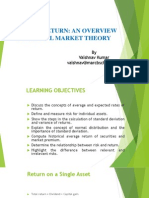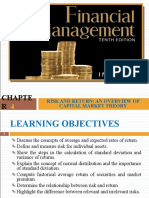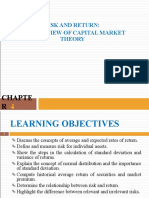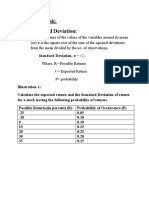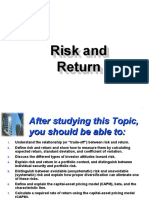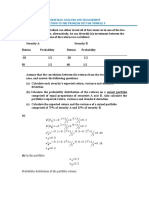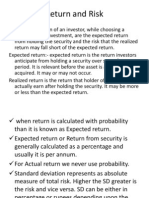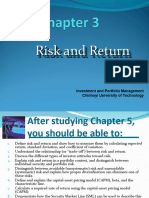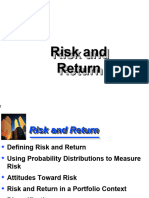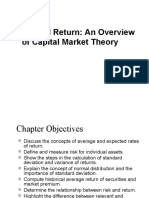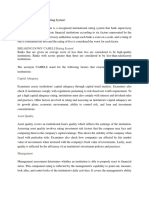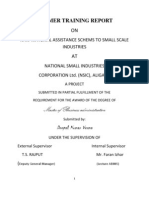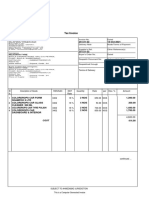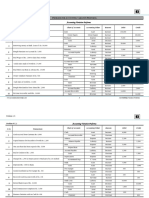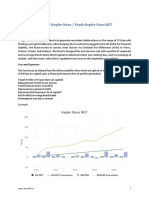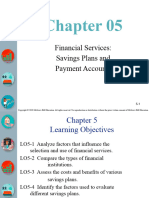FUNO_C05.
qxd 9/19/08 17:15 Page 122
Self-Correction Problems
1. Suppose that your estimates of the possible one-year returns from investing in the com-
mon stock of the A. A. Eye-Eye Corporation were as follows:
Probability of occurrence 0.1 0.2 0.4 0.2 0.1
Possible return −10% 5% 20% 35% 50%
a. What are the expected return and standard deviation?
b. Assume that the parameters that you just determined [under Part (a)] pertain to a
normal probability distribution. What is the probability that return will be zero or less?
Less than 10 percent? More than 40 percent? (Assume a normal distribution.)
2. Sorbond Industries has a beta of 1.45. The risk-free rate is 8 percent and the expected
return on the market portfolio is 13 percent. The company currently pays a dividend of
$2 a share, and investors expect it to experience a growth in dividends of 10 percent per
annum for many years to come.
a. What is the stock’s required rate of return according to the CAPM?
b. What is the stock’s present market price per share, assuming this required return?
c. What would happen to the required return and to market price per share if the beta
were 0.80? (Assume that all else stays the same.)
3. The common stocks of companies A and B have the expected returns and standard devia-
tions given below; the expected correlation coefficient between the two stocks is −0.35.
bj σj
Common stock A 0.10 0.05
Common stock B 0.06 0.04
Compute the risk and return for a portfolio comprising 60 percent invested in the stock of
company A and 40 percent invested in the stock of company B.
Problems
1. Jerome J. Jerome is considering investing in a security that has the following distribution
of possible one-year returns:
Probability of occurrence 0.10 0.20 0.30 0.30 0.10
Possible return −
0.10 0.00 0.10 0.20 0.30
a. What is the expected return and standard deviation associated with the investment?
b. Is there much “downside” risk? How can you tell?
2. Summer Storme is analyzing an investment. The expected one-year return on the invest-
ment is 20 percent. The probability distribution of possible returns is approximately
normal with a standard deviation of 15 percent.
a. What are the chances that the investment will result in a negative return?
b. What is the probability that the return will be greater than 10 percent? 20 percent?
30 percent? 40 percent? 50 percent?
3. Suppose that you were given the following data for past excess quarterly returns for
Markese Imports, Inc., and for the market portfolio:
••
�FUNO_C05.qxd 9/19/08 17:15 Page 125
Solutions to Self-Correction Problems
1. a.
POSSIBLE PROBABILITY OF
RETURN, R i OCCURRENCE, P i (R i )(Pi ) (R i − b) 2(Pi )
−0.10 0.10 −0.010 (−0.10 − 0.20)2(0.10)
0.05 0.20 0.010 (0.05 − 0.20)2(0.20)
0.20 0.40 0.080 (0.20 − 0.20)2(0.40)
0.35 0.20 0.070 (0.35 − 0.20)2(0.20)
0.50 0.10 0.050 (0.50 − 0.20)2(0.10)
Σ = 1.00 Σ = 0.200 = b Σ = 0.027 = σ 2
(0.027) = 16.43% = σ2
0.5
b. For a return that will be zero or less, standardizing the deviation from the expected return,
we obtain (0% − 20%)/16.43% = −1.217 standard deviations. Turning to Table V in the
Appendix at the back of the book, 1.217 falls between standard deviations of 1.20 and
1.25. These standard deviations correspond to areas under the curve of 0.1151 and
0.1056, respectively. This means that there is approximately an 11 percent probability
that actual return will be zero or less.
For a return that will be 10 percent or less, standardizing the deviation we obtain
(10% − 20%)/16.43% = −0.609 standard deviations. Referring to Table V, we see that
this corresponds to approximately 27 percent.
For a return of 40 percent or more, standardizing the deviation we obtain (40% − 20%)/
16.43% = 1.217 standard deviations. This is the same as in our first instance involving
a zero return or less, except that it is to the right, as opposed to the left, of the mean.
Therefore, the probability of a return of 40 percent or more is approximately 11 percent.
2. a. b = 8% + (13% − 8%)1.45 = 15.25%
b. If we use the perpetual dividend growth model, we would have
D1 $2(1.10)
P0 = = = $41.90
ke − g 0.1525 − 0.10
c. b = 8% + (13% − 8%)0.80 = 12%
$2(1.10)
P0 = = $110
0.12 − 0.10
3. b p = (0.60)(0.10) + (0.40)(0.06) = 8.4%
σp = [(0.6)2(1.0)(0.05) 2 + 2(0.6)(0.4)(−0.35)(0.05)(0.04) + (0.4)2(1.0)(0.04)2]0.5
In the above expression, the middle term denotes the covariance (−0.35)(0.05)(0.04) times
the weights of 0.6 and 0.4, all of which is counted twice – hence, the two in front. For the
first and last terms, the correlation coefficients for these weighted variance terms are 1.0.
This expression reduces to
σp = [0.00082]0.5 = 2.86%
••
















